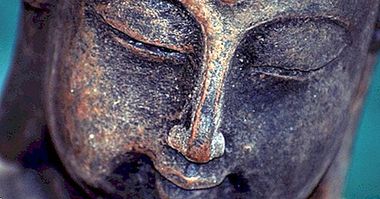8 Mindfulness activities to improve emotional health
Mindfulness, or mindfulness , is one of the most useful tools to achieve emotional balance and improve concentration and well-being of people. Its effectiveness has been proven scientifically, and there is increasing evidence that its use helps regulate emotions, reduce stress and anxiety, helps sleep better and promotes creativity. In addition, Mindfulness is also enriching for those who are totally healthy and without psychological imbalances, who simply want to live their lives more fully.
This millenary practice allows us to be in the present moment. It's a coping style that drives personal strengths and that helps to be more aware of the immediate experience with a non-judgmental attitude, of openness and acceptance. Mindfulness helps self-regulate behavior and promotes self-awareness, in addition to creating an environment conducive to well-being.
- Related article: "What is Mindfulness? The 7 answers to your questions "
Mindfulness activities for a better emotional balance
But more than a set of techniques to be in the present moment, Mindfulness it is a philosophy of life, an attitude that must be adopted to reconnect with oneself and be more aware of the reality that surrounds us. It requires practice and will, that is why it is necessary to carry out a series of activities to improve the ability to be in the here and now with a non judgmental and compassionate mentality.
There are many exercises for this purpose. Below you can find a series of Mindfulness activities for children and adults .
- Maybe you're interested: "The 11 best Mindfulness books"
Children activities
Children can also get started in the practice of mindfulness. In this way, they develop this habit that will help them to get to know each other better and to relate better to the environment, so that they can be happier in the future.
1. Breathing of the bee
The breathing of the bee, or Bhramari Pranayama It is a simple but very effective exercise to focus attention on breathing and to free the mind of agitation, frustration, anxiety and get rid of anger. Since its practice does not have great complexity, it is possible to do it in any place and even at an early age. It consists of covering the ears, closing the eyes, and when we exhale the air it is necessary to pronounce the letter "m" until the end of breathing.
Without a doubt, it is an easy exercise to practice, although it is necessary to learn diaphragmatic breathing to be able to exhale for longer. The exercise can be done as many times as you wish, but it is advisable to start with few repetitions and gradually increase them. The sound that results from this action is similar to the buzzing of a bee, so this activity is called "Breathing the bee."
2. The art of playing
To perform this exercise it is necessary to place the children in pairs. One of them is given an object (a pen, a toy, a stone, a ball, etc.), and he is asked to close his eyes. The child who has the object describes it to his partner.
After one or two minutes the same process is performed, but this time it is the other partner who is responsible for describing the object. Despite the simplicity of this activity, it is ideal to teach the little ones that they can isolate their senses and, if they wish, can focus their attention to live different experiences .
3. Attention to the bell
This exercise has two parts. The first one is to ring a bell and ask the children to listen to the sound of the bell. Children should listen carefully and raise their hands when they no longer hear the sound vibration. Afterwards, they should remain silent for a minute and pay attention to the other sounds that are heard once the sound of the bell has stopped.
When the sound ends, the children should be encouraged to share their experiences and say what they heard during this period of time. This activity works attention and full awareness, and helps connect with here and now .
4. Become a frog
Children can learn to practice Mindfulness if they become a frog for a few minutes. Frogs are a clear example of what Mindfulness is. Just as when we meditate, frogs remain immobile for a long period of time. They rarely agitate, but remain still, observing and breathing calmly, and their belly moves in a pronounced way for each inhalation and exhalation. By adopting the role of this amphibian, children they learn to sit still, to breathe in a controlled manner and to observe what happens around him without flinching.
... and for adults
Adults can practice Mindfulness in their everyday life almost anywhere, and any time is good to focus on the present moment, adopt a non-judgmental mentality and treat oneself with compassion.
5. Exercise of the five senses
This exercise is simple and It can be applied quickly in almost any situation . All that is needed is to be aware of our senses and experience each of them separately. To perform this activity, you just have to follow this order:
- Watch five things you can see . Look around and choose something you would not normally notice, such as a shadow or a small crack in the ground.
- Watch four things you can feel . Become aware of four things that you are feeling in the present moment, such as the texture of the pants, the feeling of the breeze on your skin, or the smooth surface of the table where you are resting your hands.
- Watch three things you can hear and focus on the sounds around you. For example, a bird, the noise from the refrigerator, or the sound of traffic from a nearby road.
- Watch two things that you can smell . Pay attention to the smells that you are usually not aware of and see if they are pleasant or unpleasant. The smell of the nearby pines, of the beach if you live on the coast or of a fast food restaurant near your house.
- Watch the taste of your mouth . Focus on the taste of the present moment. You can sip a drink you have on hand, chew gum, eat something and even notice the taste of your mouth without ingesting anything.
This is an easy exercise to practice, which can take you quickly to the here and now. The time you spend with each sense depends on you, but each object of attention must last one or two minutes. The idea it is not to perform a meditation, but to return to the present with an improved state of consciousness .
6. Active listening: observe non-verbal language
This activity is ideal to develop the capacity of active listening, which is a form of communication that it requires an effort on the part of our cognitive and empathic abilities , where the receiver is not a mere receiver of the words of the issuer. Many times we think that we listen when in reality we are listening.
Active listening is not listening to the other person, but being totally focused on the message that the other individual is trying to communicate. It is to be in the here and now with full consciousness. We not only focus on the words of the sender, but also on what he intends to transmit through non-verbal language.
To perform this exercise it is necessary to put in pairs . One of the members has two minutes to explain a pleasant experience of his life or an opinion about some recent event, while the other listens actively. What does your look, your posture or your gestures say? Do you look proud when you tell it? Does it transmit passion? The receiver has two minutes to carefully observe his partner's non-verbal communication. After completing the exercise, both tell their experience as active listeners.
7. Feeding Mindfulness
With the pace of life we have today, it is usual that we do not stop for a moment to connect with ourselves, even when we have a few minutes to eat, because either we put on television or we are spinning around what we have What to do this afternoon. Well, it is possible to practice Mindfulness while eating or having breakfast. Pto perform the conscious feeding exercise , you simply have to pay full attention to what you are going to eat.
You can start by focusing on what you are holding. Observe the feeling of what you have in your hands (for example, a toast or fork). Once you are aware of the texture, the weight, the color, etc., focus your attention on the smell. By last, Take the food to your mouth, but do it slowly and with full consciousness . Note the taste or texture as it melts in your mouth. This activity can help you discover new experiences with foods that you often consume.
8. Attention to the center of the image
To carry out this activity it is necessary to visualize the audiovisual content shown below :
The objective of this exercise is simple: focus attention on the point that is displayed in the center of the image despite the changing color pattern around it, which can distract or provoke unwanted thoughts. It is an ideal exercise to begin in the practice of mindfulness and to begin to become aware of the thoughts that come to mind and of which sometimes we are not aware.
The purpose of this exercise is not to get lost in these thoughts, which can be very pronounced in people prone to suffer anxiety. This experience is similar to the phenomenon of silent fixation resulting from staring at a candle flame.
To know more about Mindfulness
Everything related to Mindfulness is very interesting because of the potential of this set of simple habits to apply to everyday life, but it is also true that it is not easy to explain what it is as an activity and what are the mechanisms by which it improves our quality of life.

Fortunately, several experts in the field have been developing training workshops to make this topic more accessible. The M-PBI Mindfulness Training Program of the Mensalus Institute of Barcelona , which begins on November 14, 2018 and is now in its 18th edition, is an example of these popular awareness initiatives that are increasingly popular.
In this training program we work with both the theoretical and practical aspects of this discipline, and we teach them to apply them in different contexts, starting from the Mindfulness-based Stress Reduction Program (MBSR) of the Massachusetts Clinic and the Program. of training based on Integrated Short Practices (M-PBI) of the experts Marcial Arredondo, Pilar Hurtado and Carla Uriarte. To know more about this program that consists of 6 sessions of 3 hours and a day of retirement you can click on this link.



















